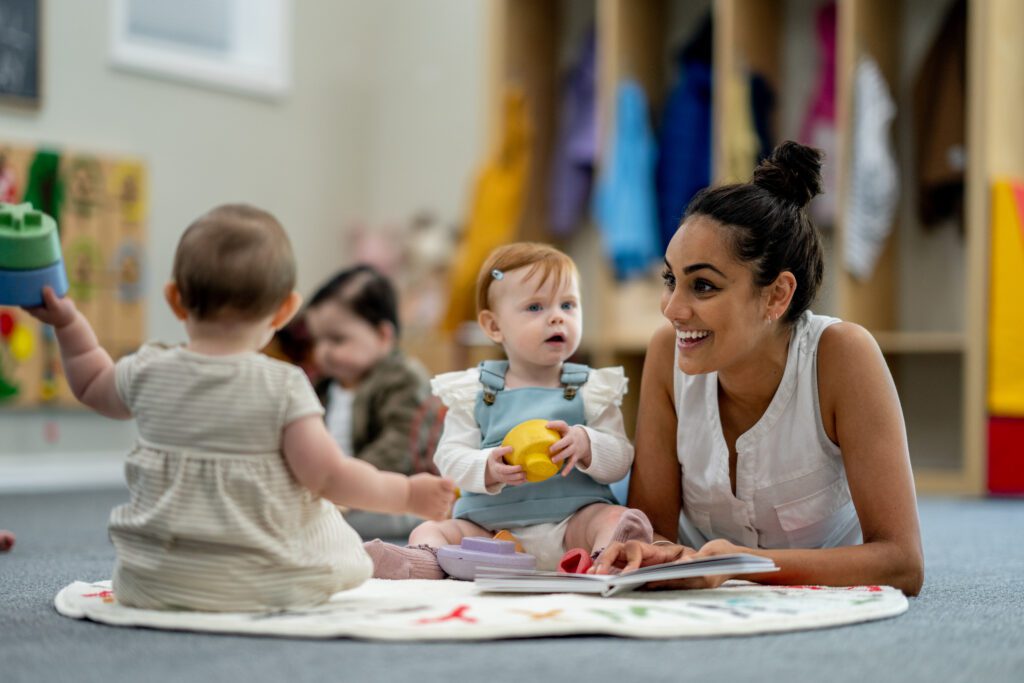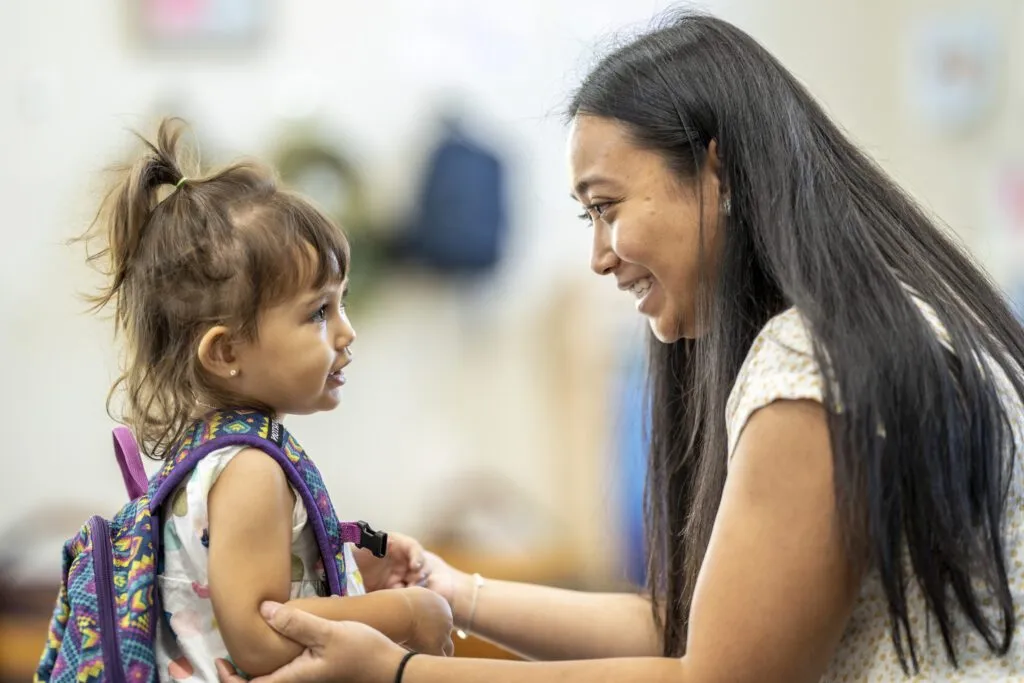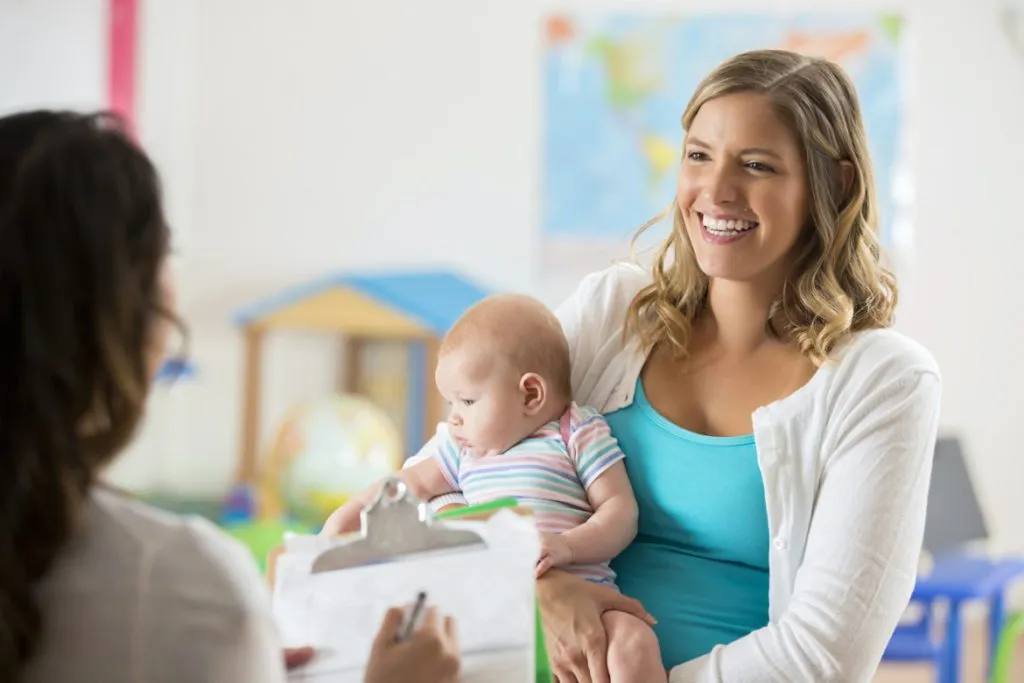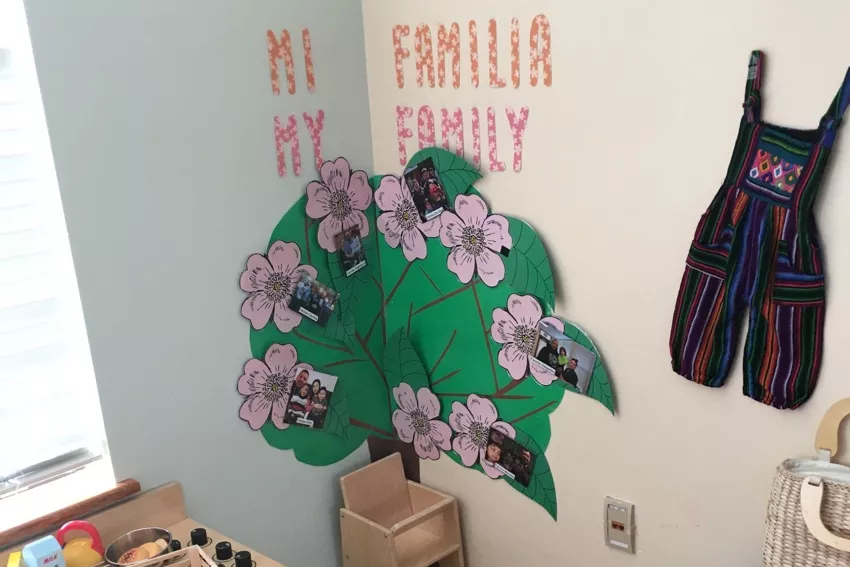Lesson Plans for Infants: Building a Learning Environment with Responsive Planning

It’s never too early to be intentional in the ways you support a child’s development and learning. Even infants (birth to 12 months) benefit from planned experiences and routines that help them discover new ideas that contribute to their cognitive, physical, language, and social–emotional development. As an educator of the youngest learners, you have unique considerations and opportunities when it comes to creating a responsive plan for intentional instruction in the safe environment of your child care center.
What do we mean by “lesson plans for infants?”
You might think of a lesson plan as an outline or template that details the instruction that you deliver for a given week or month. It often includes specific learning topics and a calendar of activities for children to participate in when they’re in the classroom. However, educators of infants cannot approach lesson planning for infants in the same ways as educators who teach older children. Caring for infants—and planning for the time you spend with them—is a very different process. Yet, it’s no less intentional and powerful than the plans that elementary, middle, and high school teachers make for the students in their care.
Instead of designing an outline with specific topics and activities at certain times, educators of infants use responsive planning to teach while caregiving and prepare for spontaneous learning opportunities. When you plan for the time you will spend with an infant, think about ways to support their daily routines and incorporate experiences that are both rich with learning opportunities and enjoyable for them. Be consistent with nurturing behaviors, paying attention to what children need and planning for possibilities.
What is responsive planning?
Responsive planning is the process of identifying the needs of young children and using that information to create a plan that fulfills those needs and anticipates opportunities for learning, including consideration for children’s individual differences. The process is informed by how infants learn and develop. For example, at six weeks an infant will demonstrate very different skills than a 6-month-old. A responsive plan for infants also considers several key elements in the learning environment, the schedule, and family engagement.
- Daily routines: Infants have daily activities, such as diapering, feeding, and dressing, that take up much of the day. A responsive plan ensures that these needs are met while making the most of the time spent on daily routines.
- Caregiving and teaching: Educators who provide intentional caregiving create learning opportunities from daily routines and engaging experiences.
- Physical environment: A responsive plan considers how the physical surroundings of a child care center will influence children’s feelings of safety, as well as their ability to learn and develop in healthy ways.
- Structure for each day: The structure of a day includes children’s daily routines and the day’s many transitions, along with time for meaningful experiences, such as enjoying books and stories and spending time outdoors.
- Family involvement: A responsive plan also considers how to build positive relationships and improve communication with families.
What does responsive planning look like?
Responsive planning allows caregivers to nurture infants’ skills and abilities as they fulfill their unique needs. As a teaching practice, responsive planning guides how caregivers approach infants’ development and learning, the learning environment, and their relationships with children’s families.
Establishes an early foundation for learning
Infants experience several milestones during the first 12 months of their lives. They’re learning every day about themselves and the people and the world around them. A responsive plan allows caregivers to guide infants to continue to develop in healthy ways, setting a foundation for learning that will support them as they grow older. Young children who have positive learning experiences during their formative years of development are likely to have positive approaches to learning in the future.
A responsive and effective plan for infants in your child care center nurtures children’s development in the following domains.
Social–emotional development
Infants who are developing social–emotional skills are identifying and managing their feelings and learning how to build relationships with other people. With responsive planning, you can create a warm, attentive atmosphere that supports infants to express themselves, feel included, and have positive interactions in your classroom. Here are examples of social–emotional skills that young and mobile infants often exhibit:
-
- turning toward something they like,
- turning away from something they dislike,
- studying the faces of familiar people, and
- becoming anxious when separated from familiar people.
Physical development
Physical development refers to an infant’s ability to move and use gross and fine-motor skills. As infants’ physical abilities change over time, responsive planning allows caregivers to adapt routines and activities to enable young children to be mobile and stay safe while exploring their surroundings. Examples of physical skills include
-
- rolling over on their backs or stomachs,
- reaching for objects,
- scooting and crawling,
- pulling up on furniture, and
- holding onto furniture while walking.
Language development
Infants understand more than what they can say, and they use sounds to communicate with the people around them. Caregivers can encourage the development of language skills in infants by speaking to them during daily routines, such as diaper changes and mealtimes. A responsive plan recognizes the value of these warm interactions and makes time for conversation. Here are examples of language skills that the children in your classroom might demonstrate:
-
- gurgling,
- cooing,
- squealing, and
- gesturing for something they want.
Cognitive development
The cognitive domain refers to the development of an infant’s brain. Creating a responsive environment in your child care center helps young children learn about the world and explore things that inspire them and make them curious. Examples of cognitive skills include
-
- noticing different textures, such as when exploring soft and hard or smooth and rough objects;
- understanding cause and effect, such as recognizing that pulling on a string makes the toy attached to the string move; and
- anticipating events, such as when an infant reacts to the sight of a caregiver picking up a diaper.
Informs an engaging learning environment
Infants who feel nurtured at a child care center are likely to respond positively to your instruction. Think about the infants in your classroom. What are they interested in? What do they like and dislike? What are their developmental strengths, and which skills require more support while the children practice them? Responsive plans will reflect the unique strengths, needs, and interests of the infants in your child care center and adapt the learning environment as needed.
A learning environment that is safe, welcoming, and organized is required to allow infants the security they need to explore and learn, but intentional attention to the learning environment, including the physical environment and daily schedule, will promote infants’ individual learning. For example, if a child demonstrates great enjoyment of a peek-a-boo activity by cooing and laughing, you might choose to repeat that activity the next day or incorporate it into her regular routines. Responding to children’s interests will help you develop trusting relationships and find ways to encourage children to practice other skills.
Supports positive relationships with families
Responsive planning can help you build positive relationships in your classroom, both with the children in your care and with their families. Infants are spending almost as much time with you as they are with members of their families, and meaningful connections between caregivers and families can ease transitions between home and your program and promote children’s learning.
Develop secure attachments and meaningful partnerships
The physical environment of a child care center is different than what infants are accustomed to in their own homes. They’re also meeting you for the first time, which means it’s a fruitful time to use responsive planning to build trust and help infants develop secure attachments to you.
Families can help you establish routines that will support their children. Responsive planning that uses families’ knowledge of their children demonstrates that you respect families as their children’s first teachers, and young children who observe their families having positive interactions with you can feel more secure in your care.
Gain valuable insights and promote children’s learning
When families trust you, they’re likely to share information about their children that can influence the care you provide. For example, a family can tell you when an infant has become more mobile at home by kicking his legs and reaching for objects. This enables you to expect more mobility when you’re changing his diaper and putting on his clothes and consider how to support his abilities with learning experiences.
Children will also benefit from receiving consistent care at home and in a daycare program. A responsive plan for children’s care incorporates information from families about children’s abilities, preferences, and habits. The more you understand the unique needs and interests of every child in your classroom, the more you can individualize your instruction to benefit all young learners.
How can I create a learning environment that supports responsive planning?
Follow these steps to create a learning environment that will help you use responsive planning to provide intentional instruction for infants in your daycare program or child care center.
Set up the physical space.
When young children are in your classroom, they should feel welcomed, safe, and included. An organized physical space enables you to supervise every child and carry out your job tasks efficiently. Designate spaces in your classroom for daily routines and meaningful experiences.
Daily routines
Daily routines provide opportunities for you to build and sustain positive interactions with infants, which makes it easier for you to establish meaningful relationships. Create a physical environment in your classroom that allows you to undergo these routines while keeping your eyes on the other children in your care.
-
- Hellos and good-byes: Choose a space near the front door to greet and say good-bye to children and their families. Infants may begin to recognize that the space is where they’ll say good-bye to their families during drop-off and reunite with them at the end of the day.
- Diapering: You’ll be using the diapering area frequently throughout the day, so choose a convenient location with a place for you to store supplies, such as diapers, baby wipes, and sanitation products. Assess the location to make sure you can supervise other children while you’re tending to one infant on the changing table.
- Sleeping: Since the infants in your care may have different sleeping schedules, reserve a quiet area in your classroom for sleeping. Be sure you have enough room for cribs and consider how you can make the lights dimmer in this area during nap time.
- Eating: An adequate eating area allows you to feed infants without facing distractions from other children in the room. Select a spot for eating that’s separate from where you change diapers.
Meaningful experiences
The environment in a child care center also requires space for purposeful play. Designate a safe area for young children to participate in developmentally appropriate activities and explore new things while practicing their social–emotional, physical, language, and cognitive skills.
Purposeful play can also take place outdoors. Think about how to organize the physical environment outside of the classroom so children will be able to make discoveries in safe ways.
Select the right materials.
Enhance learning experiences in your classroom by choosing materials that are safe and developmentally appropriate for infants to use while they play. For example, you might display a selection of squishy toys, which allow infants to practice their fine-motor skills, feel different textures, and admire different colors. Here are other characteristics to consider when finding materials.
Skill level
Suppose you’re caring for infants who are in different stages of development, such as a 3-month-old and an 11-month-old. Find toys that honor the individual skills of each child. For example, an infant who is three months old is likely to enjoy a stuffed animal that is soft to the touch and plays music when he squeezes it. An infant who is 11 months old might gravitate toward a sit-to-stand walker that helps her maintain her balance as she travels around the play area. Finding materials for all skill levels allows you to individualize care.
Favorites
Observe how the infants interact with the materials you’ve chosen. Determine if the toys are encouraging children to become mobile or understand the relationship between objects. If you’ve noticed a toy is popular among infants, consider providing multiples of the same toy so everyone has a chance to play with it. You can also ask families to identify the toys their children play with the most at home so you can display similar items in your child care center.
Homelike touches
Young children appreciate being in an environment with items that remind them of home. For example, a mobile infant may enjoy playing with a pot with a matching lid because he recognizes it as one of the items his family uses in the kitchen. Think of ways to add a homelike touch to the materials in your classroom.
Make a daily plan.
Create a structure for every day at your child care program to make the learning environment consistent and responsive. While remaining flexible and accounting for possible interruptions throughout the day, you can still make a daily schedule to stay organized as you work.
Reserve time in your schedule for daily routines. For example, you might reserve 30 minutes to greet children and families, which allows you to have positive interactions to start the day. Remember that the one-on-one interactions, including diaper changes and helping infants get dressed, present opportunities for you to introduce new topics and for children to practice their social–emotional, language, physical, and cognitive skills.
Also, leave room in your daily plan for experiences, allowing infants to play by themselves and interact in small groups. Think of your schedule from the children’s perspective and allow them to direct the pace.
Reflect and adapt.
A part of responsive planning is self-reflection. Recall what happened in your classroom on a given day and identify ways to improve the environment. Assess the physical surroundings, the materials you provided, and the schedule you followed. Did you have enough time and space to carry out daily routines? Were the materials appropriate for infants during playtime? Should you redesign your space to accommodate for an increase in mobility that you observed in the children?
As you build deeper relationships with children and their families, you’ll have more insight into how to adapt your plan to better respond to infants’ needs and interests. Reflection informs you on how to change your approach as the children in your care continue to develop.
In our curriculum for infants, toddlers, and twos, you’ll have access to Intentional Teaching Experiences, which are guides for positive experiences with young children and being intentional when caring for them. Consider exploring these guides as you reflect on your day to learn how to better respond to infants’ needs in the future.
As you create a responsive environment in your child care center, check out resources in The Creative Curriculum for Infants. This curriculum is designed for programs serving infants from 6 weeks to 12 months.


